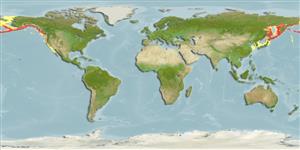分类 / Names
俗名 | 同种异名 | Catalog of Fishes(属, 种) | ITIS | CoL | WoRMS | Cloffa
Elasmobranchii
板鳃亚纲 (鲨鱼与 鱼) (sharks and rays) >
Squaliformes (Sleeper and dogfish sharks) >
Somniosidae (Sleeper sharks)
Etymology: Somniosus: Latin for sleepy, reflecting Lesueur’s surmise that these sharks are slow or sluggish because of their relatively small fins (hence the name sleeper sharks). (See ETYFish); pacificus: -icus (L.), belonging to: the Pacific Ocean (specifically, the North Pacific), where it occurs (also in Arctic Ocean). (See ETYFish).
Environment: milieu / climate zone / depth range / distribution range
生态学
海洋 底中水层性; 深度上下限 0 - 2205 m (Ref. 119696). 温带; 72°N - 23°N, 121°E - 110°W
North Pacific and Arctic: Taiwan to Japan and Kuril Islands, Sea of Okhotsk, southeastern Kamchatka, Commander and Aleutian Islands, and southern Baja California to Gulf of Alaska, Bering Sea, Chukchi Sea and Beaufort Sea.
北太平洋: 日本而且沿着西伯利亚岸边到白令海,南加州 (美国) 与墨西哥的下加利福尼亚。 偶发的记录来自南太平洋 (大南半球 Somniosus 到北太平洋 Somniosus pacificus 的任务是试验性的).(参考文献 31367) 在大洋洲水域,它生存于塔斯梅尼亚南方的海底山脉,挑战者高地 (外海的纽西兰东部) 与可能地从 Macquarie 岛.(参考文献 6871) 西南大西洋: 外海的乌拉圭 (参考文献 35864) 与巴西.(参考文献 53443)
大小 / 重量 / 年龄
Maturity: Lm ? range ? - ? cm
Max length : 440 cm TL 雄鱼/尚未辨别雌雄; (Ref. 247); 430.0 cm TL (female)
背棘 (总数): 0; 臀棘 0; 臀鳍软条: 0. Diagnosis: Somniosus pacificus differs from S. antarcticus by the following characters: interdorsal space about 70% of prebranchial length (vs. 80%); height of first dorsal fin about 3.7% of precaudal length (PCL) (vs. 3.0%); height of second dorsal fin about 3.4% of PCL (vs. 2.9%); number of turns in spiral valve 32-37 (mode 33) (vs. 36-41, mode 39); precaudal vertebrae 28-30 (mode 29) (vs. 30-31, mode 30) (Ref. 50224).
均匀略灰色-用蓝黑色的鳍粉红色; 活体可能有白色的斑点在背面上.(参考文献 6871) 短圆的吻又极圆柱状的身体与小的尾前椎鳍,大小相同的背鳍, 不对称的尾鳍有一个发展良好的腹面叶 (参考文献 6871), 第一背鳍背面更靠近腹鳍超过胸鳍,间背片的间隙少于从吻尖到第一个鳃裂的距离, 没有短的龙骨脊在尾鳍基底上, 上颚齿矛尖形的, 下颚齿有短的, 低又极倾斜尖头与高的狭窄根.(参考文献 247)
Demersal and mesobenthopelagic (Ref. 119696); found on continental shelves and slopes (Ref. 247). At high latitudes, occasionally occurs in littoral and even intertidal areas; in lower latitudes it may never come to the surface and ranges down to at least 2,000 m (Ref. 247), reported to about 2,205 m in the Hawaiian Is. as recorded by camera arrays (Ref. 119696). Feeds on bottom animals such as fishes, octopi, squids, crabs and tritons; also harbor seals and carrion (Ref. 247). Ovoviviparous (Ref. 205), with 300 pups in a litter (Ref. 247), length at birth about 42 cm or less (Ref. 26346). The flesh contains a type of toxin which, when eaten, produces symptoms of drunkenness (Ref. 583). Possibly reaches lengths greater than 700 cm (Ref. 247). It is of limited importance in fisheries, with older small-scale commercial harvests reported in southern areas; and based on its population dynamics it can be sensitive to overfishing (Ref. 117245).
栖息于大陆棚与斜坡了。 (参考文献 247) 在高的纬度,它出现于沿海地区中甚至潮间带的区域; 在低的纬度它可能从未中来到了表面,而且范围向下至至少 2,000 公尺。 (参考文献 247) 吃底部动物例如鱼,章鱼,乌贼,螃蟹与齿突; 也港区的海豹与腐肉.(参考文献 247) 卵胎生的 (参考文献 205), 藉由 300个幼胎一胎 (参考文献 247), 长度出生时大约 42 公分以内.(参考文献 26346) 肉包含一个毒素的类型, 当吃, 生产酒醉的症状.(参考文献 583) 可能地达到长度大於 700 公分。 (參考文獻 247)
Life cycle and mating behavior
成熟度 | 繁殖 | 产卵场 | 卵 | 孕卵数 | 仔鱼
Probably ovoviviparous (Ref. 247). Size at birth 42 cm or less (Ref. 26346). Distinct pairing with embrace (Ref. 205).北太平洋: 日本而且沿着西伯利亚岸边到白令海,南加州 (美国) 与墨西哥的下加利福尼亚。 偶发的记录来自南太平洋 (大南半球 Somniosus 到北太平洋 Somniosus pacificus 的任务是试验性的).(参考文献 31367) 在大洋洲水域,它生存于塔斯梅尼亚南方的海底山脉,挑战者高地 (外海的纽西兰东部) 与可能地从 Macquarie 岛.(参考文献 6871) 西南大西洋: 外海的乌拉圭 (参考文献 35864) 与巴西.(参考文献 53443)
Yano, K., J.D. Stevens and L.J.V. Compagno, 2004. A review of the systematics of the sleeper shark genus Somniosus with redescriptions of Somniosus (Somniosus) antarcticus and Somniosus (Rhinoscymnus) longus (Squaliformes: Somniosidae). Ichthyol. Res. 51:360-373. (Ref. 50224)
人类利用
渔业: 没有兴趣
更多信息
参考文献养殖养殖信息品种遗传学Electrophoreses遗传率疾病加工NutrientsMass conversion
合作者照片Stamps, Coins Misc.声音神经毒速度泳型鳃区Otoliths脑重体重比眼睛色素
工具
特别资料
下载 XML
网络资源
Estimates based on models
Preferred temperature (Ref.
123201): 0.5 - 4.5, mean 2.3 °C (based on 400 cells).
Phylogenetic diversity index (Ref.
82804): PD
50 = 0.5313 [Uniqueness, from 0.5 = low to 2.0 = high].
Bayesian length-weight: a=0.00575 (0.00316 - 0.01049), b=3.09 (2.93 - 3.25), in cm total length, based on LWR estimates for this species & (Sub)family-body (Ref.
93245).
营养阶层 (Ref.
69278): 4.4 ±0.4 se; based on diet studies.
回复力 (Ref.
120179): 低的, 最小族群倍增时间4.5 - 14 年 (Fec=300; assuming tm<=10).
Fishing Vulnerability (Ref.
59153): Very high vulnerability (90 of 100).
Climate Vulnerability (Ref.
125649): Moderate vulnerability (38 of 100).
